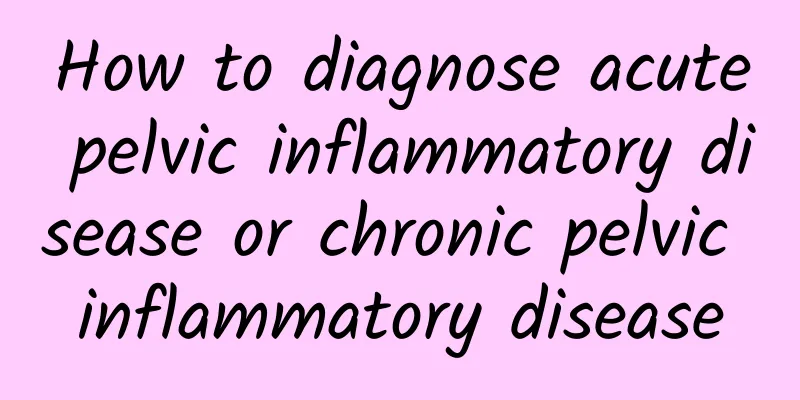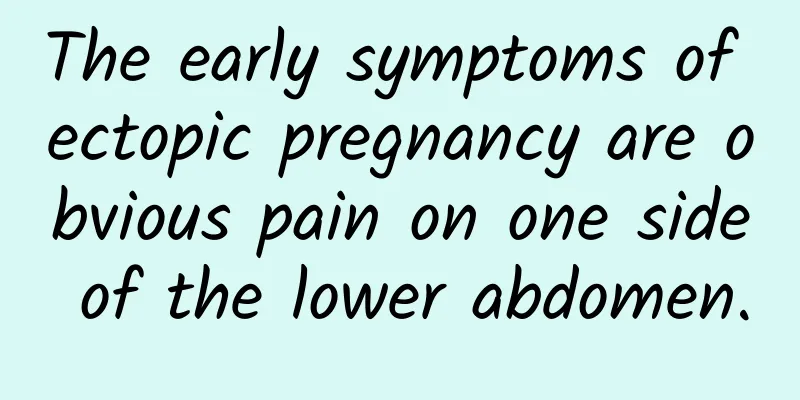How to diagnose acute pelvic inflammatory disease or chronic pelvic inflammatory disease

|
How to diagnose acute pelvic inflammatory disease or chronic pelvic inflammatory disease? Acute and chronic pelvic inflammatory disease can be diagnosed based on medical history, symptoms and signs. However, differential diagnosis must be done well. 1. Symptoms of acute pelvic inflammatory disease Acute and severe illness may cause lower abdominal pain, fever, chills, headache, and loss of appetite. During examination, the patient is found to be acutely ill, with high temperature, rapid heart rate, muscle tension, tenderness, and rebound pain in the lower abdomen. Pelvic examination: There is a large amount of purulent secretions in the vagina with obvious tenderness, tenderness and rebound pain in the uterus and bilateral adnexa, or thickening of one side of the adnexa. The main diagnoses of acute pelvic inflammatory disease include acute appendicitis, ectopic pregnancy, ovarian cyst pedicle torsion, etc. 2. Symptoms of chronic pelvic inflammatory disease The disease progresses slowly and lasts a long time. The systemic symptoms are mostly not obvious, but may include low fever, fatigue, and lower abdominal pain. During examination, the uterus is often posterior, with limited movement or fixed adhesions. The main diagnoses of chronic pelvic inflammatory disease are: endometriosis and ovarian cancer. Pelvic inflammatory disease hazards Acute pelvic inflammatory disease may cause nausea, abdominal distension, vomiting, diarrhea, etc. when there is peritonitis. When pus is formed, there may be a lower abdominal mass and local compression and irritation symptoms. If the mass is located in the front, there may be dysuria, frequent urination, urinary pain, etc., and if the mass is located in the back, it may cause diarrhea. Acute pelvic inflammatory disease may cause diffuse peritonitis or sepsis and even septic shock. Chronic inflammation leads to pelvic congestion and menorrhagia, so the consequences of chronic pelvic inflammatory disease are menstrual disorders when ovarian function is damaged, and infertility when fallopian tube adhesions are blocked. |
<<: How to treat menopausal irregular menstruation
>>: How many days after ectopic pregnancy surgery?
Recommend
Can you get pregnant with cervical erosion?
Can you get pregnant with cervical erosion? 1. Ce...
Experts: What are the symptoms of vulvar leukoplakia?
Expert’s opinion: What are the symptoms of vulvar...
When is the right time to have a painless abortion?
Painless abortion is more suitable when the pregn...
Multiple uterine fibroids symptoms and treatment methods
1. What are multiple uterine fibroids? Multiple u...
Why does endometriosis cause infertility?
Endometriosis is a disease that many women are cu...
Rely on it for postpartum weight loss! Parent-child yoga helps recovery
After giving birth, many mothers have to take car...
Collection! Blindly preserving the fetus may lead to fetal malformation
From a biological perspective, human reproduction...
Examination items and hazards of congenital absence of vagina
What are the examination items and dangers of con...
How to prevent dysmenorrhea in life
Among the many gynecological diseases, dysmenorrh...
How to prevent uterine prolapse
How to avoid uterine prolapse? Postpartum uterine...
If you eat too many rice dumplings during the Dragon Boat Festival, you may attract the three highs! Nutritionist: 3 great zongzi dishes that don’t have too much meat
The Dragon Boat Festival is approaching, and the ...
Adrenal cortex dysfunction is a cause of ovarian cysts
There are many factors that cause ovarian cysts i...
What should patients with cervical erosion eat? Cervical erosion specifically targets 6 types of women
Originally, cervical erosion is common in middle-...
How to prevent miscarriage in early pregnancy
How to prevent miscarriage in early pregnancy? Th...
Summer dietary taboos: excess or deficiency may cause health problems
As the temperature soars in the summer, the appet...









